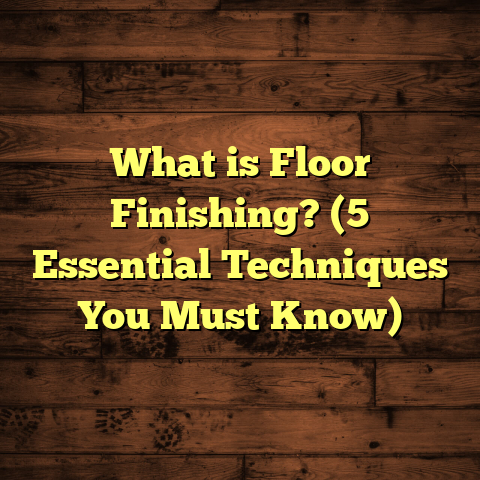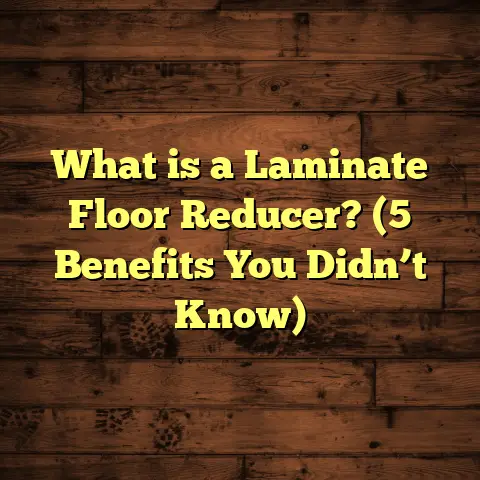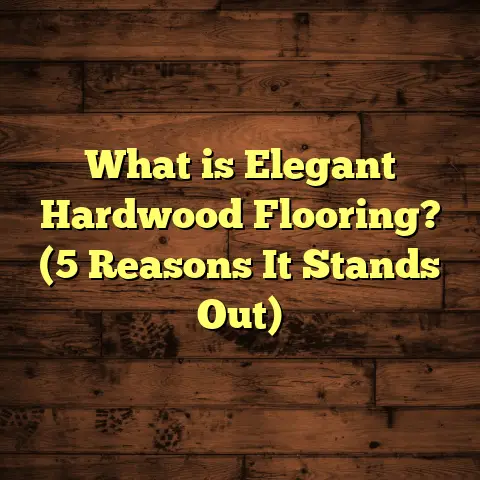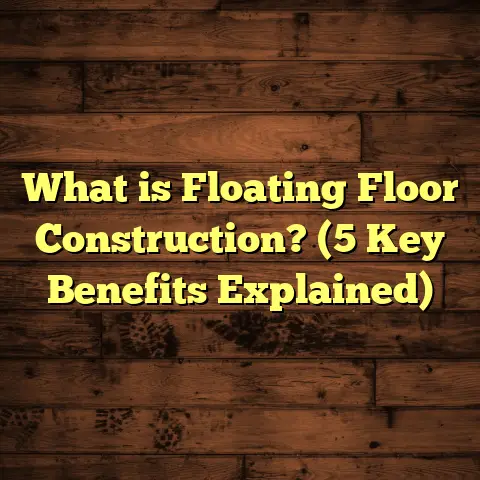What is Vinyl Flooring? (5 Must-Know Benefits for Homeowners)
I still remember the day a young couple called me about flooring options for their first home. They were overwhelmed by choices and skeptical about vinyl flooring. “Is it really worth it? Will it last?” they asked. I shared my own experiences and explained how vinyl flooring has changed dramatically over the years, becoming a durable and stylish option many homeowners now swear by. Months later, they thanked me because the floor looked brand new despite their busy household with kids and pets.
That moment reminded me how many people don’t fully understand what vinyl flooring is and the benefits it offers. So, if you’re curious about vinyl flooring and wondering if it’s right for your home, I’ll walk you through everything you need to know — from what vinyl is, to why I think it’s one of the smartest choices for homeowners today.
What is Vinyl Flooring? Breaking Down the Basics
Vinyl flooring is a synthetic flooring material made primarily from polyvinyl chloride (PVC) resin. Unlike natural materials such as hardwood or stone, vinyl is manufactured through a multi-layered process that creates a resilient, flexible, and water-resistant floor covering.
Here’s how the layers typically stack up:
- Wear Layer: The topmost protective film that guards against scratches, stains, and fading. This layer determines the floor’s durability.
- Decorative Layer: A high-resolution printed design that gives vinyl its realistic appearance—whether that’s wood grain, stone texture, or abstract patterns.
- Core Layer: Provides stability and cushioning. Depending on the type of vinyl (sheet, tile, or plank), this layer can vary in thickness and rigidity.
- Backing Layer: Offers moisture resistance and helps keep the floor flat and secure.
Vinyl flooring comes mainly in three types:
- Sheet Vinyl: Large continuous sheets that are water-resistant and commonly used in kitchens and bathrooms.
- Luxury Vinyl Tile (LVT): Tile-shaped pieces that mimic natural stone or ceramic tiles.
- Luxury Vinyl Plank (LVP): Planks designed to look like hardwood floors, with realistic textures and colors.
The beauty of vinyl’s construction is that it combines strength with style flexibility. Vinyl can be installed over many existing floors, making renovations faster and often less expensive.
Benefit 1: Durability That Surprises Many Homeowners
Durability is where vinyl really shines in my experience. When I first started installing floors over 15 years ago, vinyl was often dismissed as cheap or temporary. That couldn’t be further from the truth now.
How Durable Is Vinyl?
According to a 2023 industry survey by Floor Focus magazine, modern vinyl floors with thick wear layers can withstand up to 15,000 cycles on the Taber abrasion test—an industry standard for measuring surface wear resistance. For context:
- Hardwood floors typically rate between 3,000 to 4,000 cycles.
- Laminate floors range from 7,000 to 12,000 cycles.
- Vinyl flooring can exceed these numbers depending on quality.
This means vinyl can endure heavy foot traffic from families, pets, and even commercial use without showing wear quickly.
Real-Life Example
One of my clients owns a daycare center with over 20 kids running around daily. We installed luxury vinyl tiles in their play area. After two years, despite spills, scratches from toys, and constant cleaning, the floor looked almost new. They saved thousands on what would have been expensive tile repairs or hardwood maintenance.
Resistance to Moisture and Damage
Vinyl’s waterproof nature makes it ideal for moisture-prone areas like kitchens, bathrooms, basements, or laundry rooms. I’ve seen homes where hardwood floors warped or stained due to water damage while their adjacent vinyl kitchen held up perfectly after spills and splashes.
In fact, a study by the National Floor Safety Institute found that homes with vinyl flooring reported 40% fewer moisture-related issues than those with hardwood or laminate.
Benefit 2: Cost-Effective Flooring That Doesn’t Skimp on Style
Let’s talk money. Vinyl flooring offers a balance between affordability and aesthetics that appeals to many homeowners I work with.
Breaking Down the Costs
Vinyl typically costs between $2 to $7 per square foot for materials depending on quality and design complexity. Installation ranges from $1 to $5 per square foot based on labor rates and subfloor preparation needs.
For example:
- Basic sheet vinyl: Around $2-$3 per sq ft.
- Mid-range luxury vinyl planks (LVP): $3-$5 per sq ft.
- High-end luxury vinyl tiles (LVT): Up to $7 per sq ft.
Compared to hardwood floors that can cost $8-$15 per square foot installed, or natural stone tiles that can run $10-$20+, vinyl is far more accessible for tight budgets.
How I Use FloorTally to Manage Costs
When I plan a project, estimating costs accurately is crucial. I use FloorTally — a tool that helps me calculate flooring expenses based on local material prices and labor rates in real-time. It factors in waste percentages (usually about 5-10%), installation types, and even different product grades.
For instance, for a recent 1,200 sq ft kitchen/family room renovation using luxury vinyl planks:
- FloorTally helped me quickly see total project costs at around $5,800 including materials and labor.
- I could adjust variables like choosing a thicker wear layer or different brand to see how it affected pricing.
- This saved time negotiating with suppliers and gave my clients clear expectations on budget upfront.
By keeping budgeting transparent and straightforward like this, I avoid surprises later on — which makes everyone happy.
Style Variety at Every Price Point
What surprises many people is how realistic modern vinyl looks without a hefty price tag. Thanks to digital printing technology advances, you can get vinyl that mimics hand-scraped hardwood or natural slate at a fraction of the cost.
I had one client who wanted the look of reclaimed oak but couldn’t afford real wood. We installed luxury vinyl planks with textured surfaces that fooled even their most discerning guests.
Benefit 3: Easy Maintenance That Fits Busy Lifestyles
After installation, how much work do you think it takes to keep vinyl floors looking great? From what I’ve seen firsthand, very little.
Cleaning Made Simple
Vinyl floors only need regular sweeping or vacuuming to remove dirt and grit that might scratch the surface. For spills or sticky spots, a damp mop with mild detergent is enough — no waxing or special cleaners required.
A 2024 Home Floor Trends survey found that nearly 80% of vinyl floor owners chose it because it fits their busy schedules and demands minimal upkeep.
My Own Experience
I installed luxury vinyl in my own kitchen five years ago. Between cooking messes, kids dropping snacks regularly, and pet paws tracking dirt inside, this floor has been through a lot. But all I do is sweep daily and mop once a week — no stains or dulling so far.
Maintenance Tips I Share With Clients
- Avoid abrasive scrubbers or harsh chemicals.
- Use furniture pads under heavy items.
- Clean spills promptly to avoid staining wear layers (though most vinyl is highly stain resistant).
- Periodically check seams for lifting if adhesive was used.
With these small efforts, vinyl floors can maintain their fresh look for years without costly upkeep.
Benefit 4: Comfort Underfoot and Noise Reduction Benefits
Have you ever stood barefoot on tile or stone floors for a long time? It can be rough on your feet and joints. Vinyl feels different — softer and warmer.
Why Vinyl Feels Better
Luxury vinyl products often have cushioned core layers made from foam or cork composites underneath the surface layer. This adds comfort by absorbing impact as you walk or stand.
I always recommend this feature to homeowners who spend lots of time in their kitchens or family rooms where kids play on the floor.
Noise Dampening Qualities
Hard surfaces like tile can amplify sound echoes in a room. Vinyl’s layered structure helps reduce noise transmission—making homes feel quieter. This was especially important when I installed vinyl in an open-plan condo where neighbors complained about footsteps before.
Studies show impact noise reduction ratings for luxury vinyl range from 18 to 24 decibels depending on product thickness—a noticeable difference compared to harder surfaces.
Benefit 5: Stunning Designs That Match Any Home Style
One thing that continues to impress me is how far design options have come with vinyl flooring.
Going Beyond Traditional Looks
Whether you want rustic farmhouse charm, sleek modern vibes, or classic Mediterranean tile aesthetics — there’s probably vinyl flooring to match your vision.
Manufacturers use advanced photographic printing combined with embossed textures so patterns feel true-to-life when touched or viewed closely.
Personal Stories on Style Choices
I once helped a client select luxury vinyl planks that looked exactly like whitewashed oak with vintage distressing—perfect for her coastal-themed living room. Another client wanted bold black hexagonal tiles but worried about grout maintenance; luxury vinyl tile replicated this look without grout lines or extra cleaning hassle.
Customization Options
Some brands even offer customizable designs where you can choose colors or patterns tailored to your space. This kind of flexibility opens up creative possibilities without the cost of custom hardwood or imported stone.
Comparing Vinyl Flooring to Other Popular Flooring Types
To help you see where vinyl stands out more clearly, here’s how it compares with other common options:
| Flooring Type | Cost (per sq ft) | Water Resistance | Durability | Maintenance | Style Options |
|---|---|---|---|---|---|
| Vinyl Flooring | $2 – $7 | Excellent | High | Low | Very high |
| Hardwood Flooring | $8 – $15 | Poor | Moderate | Moderate to high | Very high |
| Laminate Flooring | $3 – $8 | Moderate | Moderate | Moderate | High |
| Ceramic Tile | $5 – $15 | Excellent | Very high | Moderate | High |
| Carpet | $3 – $7 | Poor | Low | High | Moderate |
Vinyl flooring hits a sweet spot for affordability combined with water resistance and durability unmatched by laminate or carpet—and at lower cost than hardwood or tile in many cases.
Installation Insights: What I’ve Learned Over Years on the Job
Installing vinyl flooring isn’t rocket science but there are some key tips I share after hundreds of projects:
Subfloor Preparation Is Crucial
Whether installing sheet vinyl or luxury planks, your subfloor needs to be clean, dry, level, and free from debris. Imperfections can cause bumps or premature wear.
Installation Methods Vary
- Sheet Vinyl: Usually glued down or loose-laid in smaller areas.
- Luxury Vinyl Planks/Tiles: Often come as click-lock systems for DIY-friendly floating floors.
- Glue-down LVT: Used in commercial settings or high-moisture areas for extra security.
Time Savings
I find installing LVP can be done twice as fast as hardwood because there’s no need for sanding or finishing afterward. This means less disruption at home during renovations.
Common Installation Challenges
Avoid installing over carpet or uneven surfaces without proper underlayments. Also watch out for moisture issues in basements—use moisture barriers when needed.
Caring for Your Vinyl Floors: Tips From My Experience
To keep your floors looking fresh long-term:
- Sweep frequently to prevent grit damage.
- Mop with pH-neutral cleaners designed for vinyl.
- Avoid waxes or polishes—they can leave residue.
- Use protective pads under furniture legs.
- Address any spills immediately.
- Don’t drag heavy furniture across floors without protection.
Following these simple steps has helped my clients enjoy beautiful floors without costly repairs down the line.
Addressing Common Homeowner Concerns About Vinyl Flooring
Will it fade over time?
High-quality vinyl has UV-resistant coatings that minimize fading even in sunny rooms. Still, consider curtains or blinds if direct sunlight exposure is prolonged.
Is it eco-friendly?
Vinyl production uses PVC plastics which aren’t biodegradable. However, many brands now produce low-VOC products and participate in recycling programs to reduce environmental impact.
Can it be repaired if damaged?
Small scratches can sometimes be buffed out or covered with repair kits. Individual planks or tiles can be replaced if necessary without removing entire floor sections.
How does it feel compared to hardwood?
Vinyl tends to be softer underfoot but doesn’t have the same warmth as real wood. However, some luxury options include cork backing for added warmth and comfort.
Final Thoughts on Why Vinyl Flooring Makes Sense Today
When I reflect on all the projects I’ve been part of—homes big and small—I see a pattern: homeowners want floors that look great but don’t require hours of maintenance or break their budgets. Vinyl flooring fits right into this sweet spot offering durability, style variety, easy upkeep, comfort, and cost savings in one package.
If you’re thinking about new floors for your kitchen, basement, bathroom—or even an entire house—vinyl deserves serious consideration. With modern materials and installation methods improving constantly, you don’t have to sacrifice beauty for practicality anymore.
Feel free to ask any questions about your specific situation! I’m always here to share what I’ve learned from years of hands-on experience installing all kinds of flooring options.





